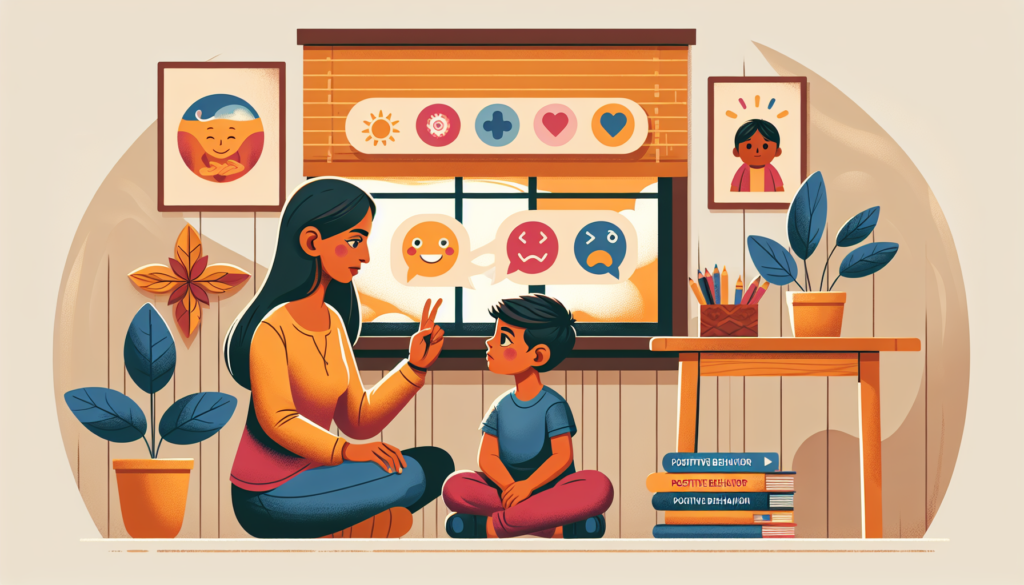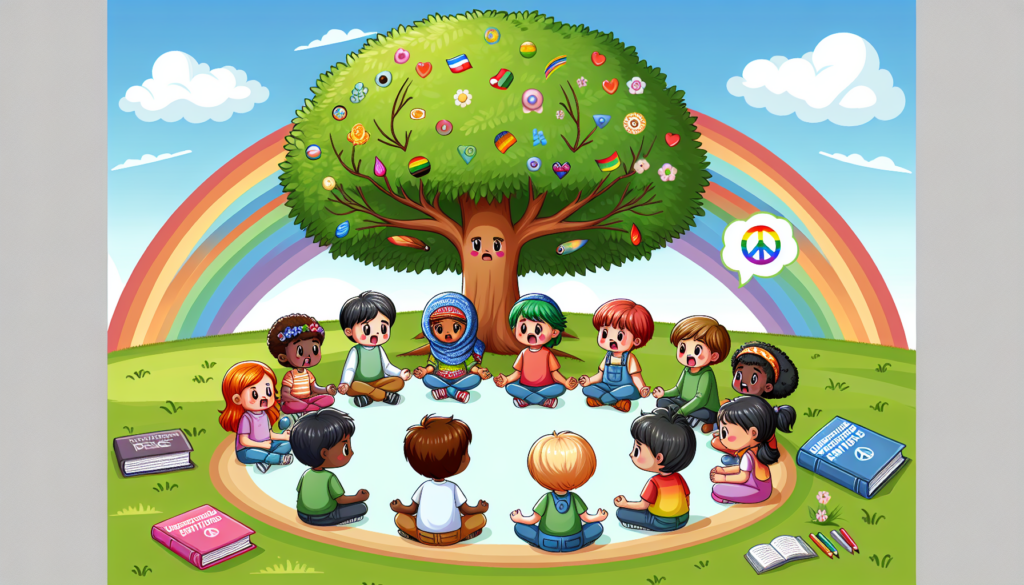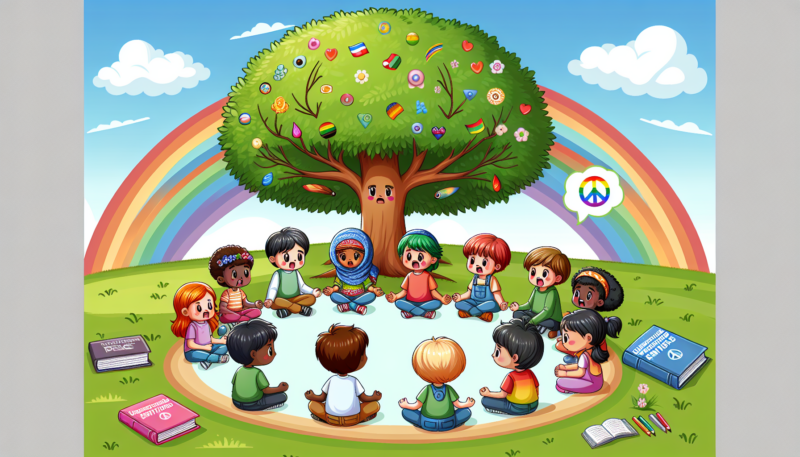Are you tired of your child resorting to hitting when they are upset or frustrated? It can be a challenging behavior to address, but with the right strategies, you can teach your kid to stop hitting and find more constructive ways to express their emotions. In this article, we will provide you with 10 valuable tips that will help you guide your child towards healthier outlets for their feelings, fostering a peaceful and respectful environment for everyone involved.
Setting Clear Expectations
Emphasizing non-violence
When it comes to teaching your child to stop hitting, it’s crucial to set clear expectations right from the start. Let your child know that hitting is never an acceptable behavior and that violence is not the solution to any problem. By emphasizing the importance of non-violence, you are instilling in your child the value of resolving conflicts peacefully and treating others with respect and kindness.
Explaining the consequences
In order for your child to understand the gravity of their actions, it’s essential to explain the consequences that accompany hitting. Make it clear to them that hitting can hurt others physically and emotionally, and it can damage relationships. By helping your child grasp the negative impact of their behavior, you are encouraging them to think twice before resorting to physical aggression.
Setting boundaries and rules
Setting clear boundaries and rules is an effective way to teach your child about appropriate behavior. Clearly communicate your expectations and establish consequences for hitting, such as time-outs or loss of privileges. Be consistent in enforcing these rules and ensure that your child understands the consequences they will face if they choose to hit. Providing structure and guidance will help your child develop a better understanding of acceptable behavior and the importance of following rules.
Modeling Good Behavior
Leading by example
Children often learn by observing and imitating those around them, especially their parents or caregivers. As a role model, it’s essential to exhibit good behavior and demonstrate healthy ways to deal with conflicts. Show your child how you handle disagreements without resorting to violence. By consistently modeling non-violent behavior, you are providing them with a positive example to emulate.
Showing appropriate conflict resolution
Conflict is a part of life, and it’s crucial to teach your child how to resolve disagreements in a respectful and peaceful manner. Encourage open communication and problem-solving techniques such as compromise and active listening. By demonstrating these skills during your own conflicts, you are showing your child that there are alternatives to hitting and that conflicts can be resolved through dialogue and understanding.
Avoiding aggression
It’s important to create a peaceful and nurturing environment for your child by avoiding any form of aggression yourself. Avoid yelling, shouting, or using physical force as a means to gain control or dominance. Instead, practice patience, understanding, and assertive communication. By maintaining a calm and non-aggressive demeanor, you are providing your child with a safe and secure emotional space, which can significantly reduce the likelihood of them resorting to hitting as a means of expression.

Promoting Emotional Intelligence
Encouraging emotional expression
Children may resort to hitting as a way to express their emotions, particularly when they don’t possess the skills to communicate their feelings effectively. Encourage your child to express their emotions verbally and help them identify their feelings. Teach them appropriate words to describe their emotions, such as “I feel angry” or “I feel frustrated.” By fostering emotional expression, you are enabling your child to communicate their feelings in a healthier and non-violent manner.
Teaching empathy
Empathy is a critical aspect of emotional intelligence. Help your child understand the impact their actions can have on others by teaching them empathy. Encourage them to put themselves in someone else’s shoes and ask how they would feel if they were on the receiving end of a hit. By developing a sense of empathy, your child will become more aware of the consequences of their actions and be more inclined to treat others with kindness and compassion.
Building frustration tolerance
Children who struggle with frustration are more likely to resort to hitting when they encounter challenges or obstacles. Help your child build frustration tolerance by teaching them healthy coping mechanisms. Encourage them to take deep breaths, count to ten, or engage in a calming activity when they feel overwhelmed. By equipping your child with these coping strategies, you are empowering them to handle frustration in a constructive manner, reducing the likelihood of hitting out of frustration.
Teaching Alternative Coping Mechanisms
Encouraging verbal communication
Effective communication is essential in preventing hitting. Encourage your child to express their feelings and needs through clear and respectful verbal communication. Teach them appropriate phrases or sentences they can use when they are upset, such as “I don’t like that” or “Please stop.” By promoting verbal communication, you are providing your child with a healthier and non-violent outlet for expressing themselves.
Using calming techniques
When your child is feeling overwhelmed or on the verge of hitting, teach them calming techniques to help them regain control. Breathing exercises, such as taking deep breaths and exhaling slowly, can be incredibly effective in reducing anger and frustration. Additionally, teach your child simple relaxation techniques like progressive muscle relaxation or visualization exercises to help them calm down in tense situations.
Introducing stress-relief activities
Engaging in stress-relief activities can help redirect your child’s energy and provide them with healthier outlets for their emotions. Encourage activities such as drawing, painting, playing a musical instrument, or engaging in physical exercise. These activities allow your child to release any pent-up emotions in a constructive and non-violent manner, reducing the likelihood of hitting.

Reinforcing Positive Behavior
Using praise and rewards
Positive reinforcement is a powerful tool in shaping behavior. Whenever your child demonstrates non-violent behavior, whether it’s resolving a conflict peacefully or expressing their emotions verbally, make sure to acknowledge and praise their efforts. This positive recognition will reinforce the idea that non-violence is valued and appreciated. Consider implementing a rewards system where your child can earn small rewards for consistently exhibiting non-violent actions.
Focusing on non-violent actions
It’s important to shift the focus onto non-violent actions and behaviors. When your child hits or displays aggression, redirect their attention to alternative actions they can take. Encourage them to use their words, walk away from a situation that upsets them, or seek help from a trusted adult. By consistently highlighting and promoting non-violent alternatives, you are reinforcing the idea that hitting is not an acceptable or effective means of communication.
Implementing a reward system
Consider implementing a reward system to encourage and reinforce positive behavior consistently. Set achievable goals and provide rewards when your child meets them, such as stickers, special privileges, or quality time spent together. This system creates motivation and encourages your child to consistently practice non-violence, ultimately helping them break the cycle of hitting.
Implementing Consistent Discipline
Establishing fair consequences
Consistent discipline is essential in teaching your child to stop hitting. Establish clear consequences for hitting, such as time-outs or loss of privileges. Ensure that these consequences are fair and proportionate to the behavior. By providing consistent and fair consequences, your child will begin to understand the direct link between their actions and the outcomes they face, reinforcing the importance of non-violence.
Avoiding physical punishment
While it may be tempting to resort to physical punishment when your child hits, it’s important to avoid this approach. Physical punishment not only models the very behavior you are trying to eliminate but also promotes the idea that violence is an acceptable means of discipline. Instead, focus on non-violent consequences that allow your child to understand the impact of their actions without resorting to physical harm.
Consistency in discipline
Consistency is key in teaching your child to stop hitting. Enforce the consequences you have established consistently, ensuring that they are applied every time your child engages in hitting behavior. By providing a consistent response, you are setting clear boundaries and expectations, making it easier for your child to understand the consequences of their actions.
Open Communication and Trust
Creating a safe space for dialogue
Open communication is vital when teaching your child to stop hitting. Create a safe and non-judgmental space for your child to express their feelings, concerns, and frustrations. Let them know that they can come to you with any problems and that you are there to listen and support them. By fostering open communication, you are encouraging your child to express themselves verbally rather than resorting to hitting.
Building trust with your child
Building trust is crucial in any parent-child relationship. To help your child feel comfortable opening up to you, be reliable, understanding, and patient. Show them that you are there for them and that they can trust you. This trust will create a solid foundation for healthy communication and allow you to address any underlying issues that may be contributing to their hitting behavior.
Listening actively
Active listening is an essential skill for effective communication. When your child is expressing their feelings or concerns, give them your undivided attention and truly listen to what they have to say. Reflect their feelings back to them to show that you understand their perspective and empathize with their emotions. By actively listening, you are validating your child’s feelings and demonstrating that their voice matters.
Identifying Triggers and Patterns
Understanding the cause of hitting
To effectively address your child’s hitting behavior, it’s crucial to understand the underlying cause. Is your child hitting out of frustration, to gain power, or due to emotional distress? Pay close attention to the triggers that precede hitting incidents and try to identify any patterns in their behavior. This understanding will help you tailor your approach and provide targeted interventions to address the specific needs of your child.
Recognizing patterns of behavior
Patterns of behavior can shed light on the underlying factors contributing to hitting. Notice if your child tends to hit when they are tired, hungry, or feeling overwhelmed. Look for any consistent patterns or situations that lead to hitting incidents. Once you recognize these patterns, you can take proactive steps to address the triggers or adjust your child’s environment to prevent hitting from occurring.
Addressing underlying issues
Hitting is often a symptom of underlying emotional or developmental issues. If your child’s hitting behavior persists despite your efforts, it may be beneficial to seek professional guidance. A child psychologist or therapist can help identify and address any underlying issues contributing to the hitting behavior. They can provide specialized strategies and interventions to support your child’s emotional well-being and teach them healthier ways to cope with their emotions.
Seeking Professional Guidance
Consulting with a child psychologist
If you find that your child’s hitting behavior persists or worsens despite your best efforts, consider seeking the guidance of a child psychologist or therapist. These professionals specialize in child behavior and can provide valuable insights and strategies to address the hitting behavior effectively. They can also help you navigate any underlying emotional or developmental challenges that may be contributing to your child’s behavior.
Joining parenting support groups
Support from other parents who have experienced similar challenges can be incredibly helpful. Consider joining parenting support groups, either in-person or online, to connect with other parents who are dealing with or have overcome hitting behavior in their children. These groups provide a supportive and non-judgmental environment where you can share your experiences, exchange strategies, and gain valuable insights from others who have been in similar situations.
Attending workshops or classes
Many community organizations and parenting centers offer workshops or classes on child behavior and effective discipline techniques. These resources can provide you with additional strategies, techniques, and tools to address your child’s hitting behavior. Attending these workshops and classes can also give you the opportunity to connect with other parents and gain further support and guidance.
Patience and Persistence
Understanding change takes time
It’s important to remember that change takes time and patience. Breaking the habit of hitting is a process, and it may not happen overnight. Be patient with your child and with yourself as you navigate this journey. Celebrate small victories along the way and acknowledge the progress your child is making. Remember that your consistent efforts will pay off in the long run.
Being consistent in efforts
Consistency is key when teaching your child to stop hitting. Be consistent in your approach, expectations, and consequences. Follow through with the strategies and interventions discussed and remain steadfast even during challenging times. Consistency sends a clear message to your child that hitting is unacceptable and will not be tolerated in any situation.
Staying calm and composed
Hitting incidents can be frustrating and overwhelming for both you and your child. It’s important to stay calm and composed when addressing your child’s hitting behavior. Reacting with anger or aggression will only escalate the situation and send mixed messages. Take deep breaths, step away if needed, and come back to the situation when you can respond calmly. Your calm responsiveness will model emotional regulation for your child and set the stage for effective resolution.
In conclusion, teaching your child to stop hitting requires setting clear expectations, modeling good behavior, promoting emotional intelligence, teaching alternative coping mechanisms, reinforcing positive behavior, implementing consistent discipline, fostering open communication and trust, identifying triggers and patterns, seeking professional guidance when needed, and maintaining patience and persistence throughout the process. By following these tips and investing your time and energy, you can help your child learn healthier ways to navigate their emotions and conflicts, ultimately leading to a happier and more peaceful family dynamic.
